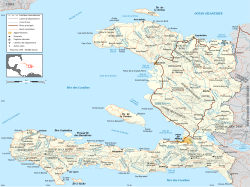


Agriculture in Haiti describes the tortured agricultural history of an island nation once described as the "Pearl of the Antilles". The Taíno people were the farming inhabitants of the island when the Spanish first visited in the late 15th century. The Taino died out from European diseases and exploitation and were replaced with imported African slaves. In the 18th century, Haiti became a country of large plantations, especially of sugar cane, owned by Europeans and worked by hundreds of thousands of slaves. The slaves revolted in 1791 and gained independence from France. The plantations were broken up and the land was distributed to former slaves who primarily engaged in subsistence agriculture with coffee as their most important cash crop and as Haiti's most important export.
In the late 20th and early 21st centuries, authoritarian government, corruption, foreign military interventions, environmental degradation, natural disasters, gang violence, internationally-imposed economic policies, and loss of foreign markets for products such as coffee served to make Haiti the poorest country in the Americas and one of the poorest countries in the world. Agriculture in Haiti consists mostly of subsistence farmers eking out a living from small plots of land. The country has had to import large quantities of food, especially rice, to feed its populace. Although about 50 percent of Haiti's population was still rural in the 21st century, many farmers have abandoned the land and moved to the cities. Rural conditions have contributed to environmental problems such as soil erosion and deforestation.